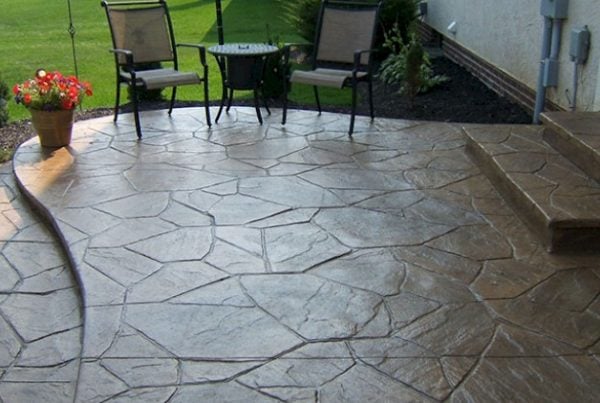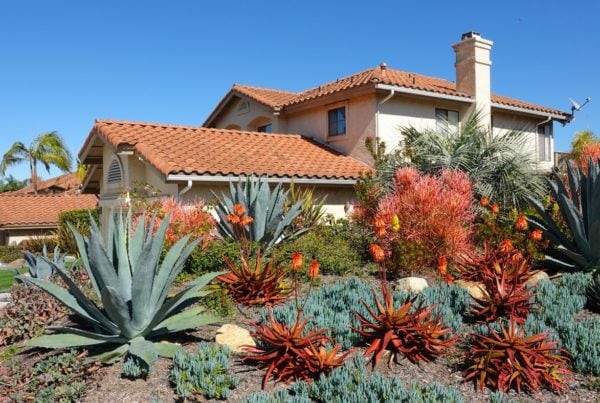Winter landscapes don’t have to look cold, stark and dreary. With the right landscaping strategies, you can create a more inviting atmosphere with color and life. Learn how to add texture and beauty to your yard with these winter landscape design tips.
Add Some Artificial Light
Winter can be bleak. but modern technology provides a solution. Vivid LED lights can really bring your view to life, giving color to an otherwise barren sight. These lights are particularly useful if you have something to illuminate, such as a giant tree, outdoor ornaments or a featured piece in your garden. Don’t be afraid to incorporate colors, but avoid going over the top with multi-colored lights.
Plant Needled Evergreens
Prized for their year-round beauty, hearty needled evergreens add color and texture to a drab winter landscape. They can have green, blue or even yellow needles, depending on your preference. Eastern white pines, for instance, are magnificent trees with gorgeous bright green needles. While some consider them messy because of dropped cones and needles, Eastern whites can make a beautiful statement amid bleak winter settings.
With their shorter needles, fir and spruce trees are also attractive options because they blend varying shades of greens and, in some instances, even blue tones. Needled evergreen shrubs and certain types of yews, arborvitae and cypress are also good options. You can also add some excellent ornamental, vertical accents with dwarf versions of needled trees, including dwarf pines, hemlocks, spruces and cypresses.
Consider Fruiting Plants
Certain winter landscaping plants produce colorful berries and other fruit that lasts through much of the winter. The flowering Harvest Gold Crabapple tree, for example, is uniquely beautiful because it produces noticeable yellow fruit that can significantly brighten up a cold landscape.
Varieties of holly, such as Coral Berry and Viburnum, are also attractive options. Shrubs such as Winterberry hollies lose their leaves while retaining their berries, making for beautiful winter displays especially atop snow cover against the backdrop of needled evergreens. With their bright red berries, Winter King Hawthorns are another great choice.
Viking black chokeberry provides foliage that ranges from purple to red in fall, making it a lovely two-season standout. Chokeberry berries can also serve as emergency food for beautiful wild birds. That said, because these astringent berries aren’t a bird’s first choice, they tend to stick around well into early winter.
 Add Some Color with Semi-Evergreens
Add Some Color with Semi-Evergreens
Often referred to as semi-evergreen, there are several attractive plants that only briefly shed their foliage in winter and then rejuvenate quickly. Nandina varieties, for instance, hold onto a nice proportion of their leaves and flowers even as the weather turns cold. They can also change color in response to cold. The Blush Pink Nandina, for example, will turn pink or even red during the late fall and early winter, adding a striking pop of color that illuminates your winter landscape.
Certain Viburnum varieties, such as Leatherleaf, are also semi-evergreen. This coarsely textured shrub has a blue-green appearance that stands out in stark surroundings. There are also certain species of Azalea that are considered semi-evergreen.
Inspire Activity and Life
The unsung heroes of cold-weather landscapes, birds can uplift a cold, lonely yard. While their movements are often hidden by lush vegetation during the spring and summer; their playful antics are much more noticeable during the winter.
Attract more birds by leaving dormant perennials such as black-eyed Susan, ornamental grasses, coneflower, and others in place over the winter. Their seed heads provide interest, and birds will enjoy pawing for seeds throughout the winter. You should also provide a reliable water source that won’t regularly freeze over.
By far the best way to attract winter birds is by planting trees and shrubs that are native in your area. Since birds are used to finding shelter and food in plants that grow naturally, you will attract more activity by planting more native vegetation. Some good old-fashioned birdseed can also help, especially if you live in an urban area.
At RMPS Landscaping in Castle Rock, we provide a full spectrum of landscaping services, from stonework and hardscaping to water features, outdoor lighting, plants, trees, sod and whole-scale landscape renovations. Visit our featured projects resource for inspiration, and contact us to learn how we can help bring your vision into the real world.





